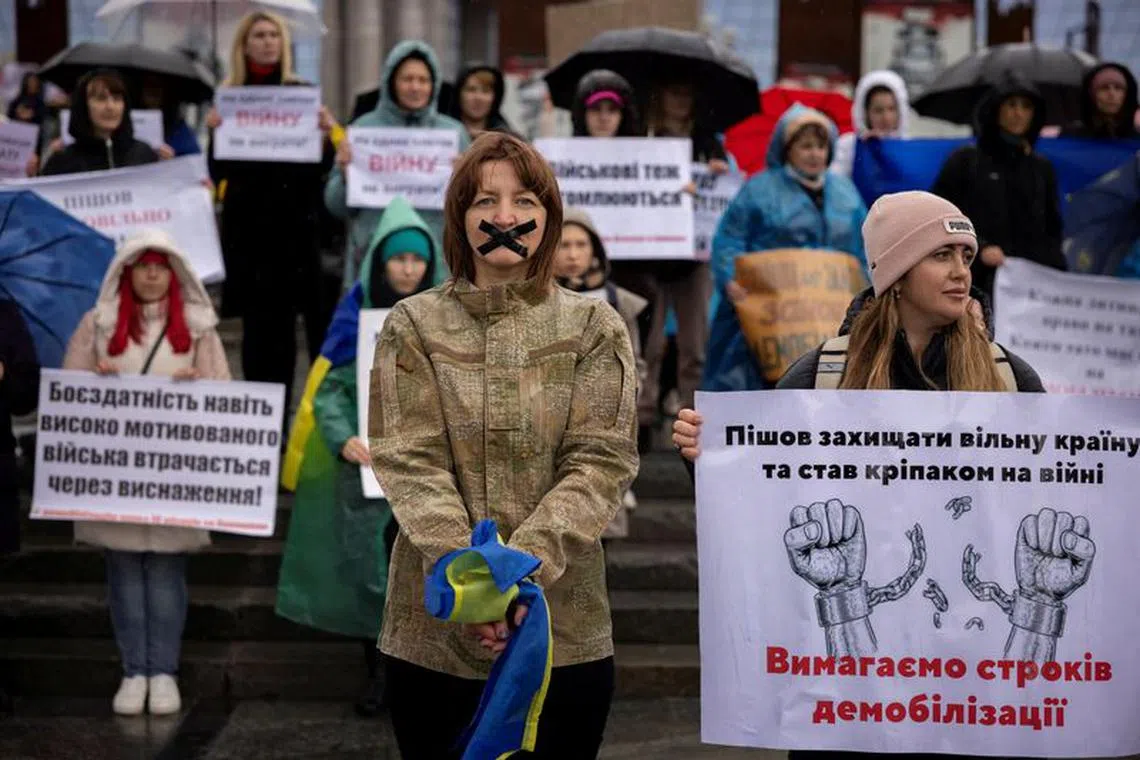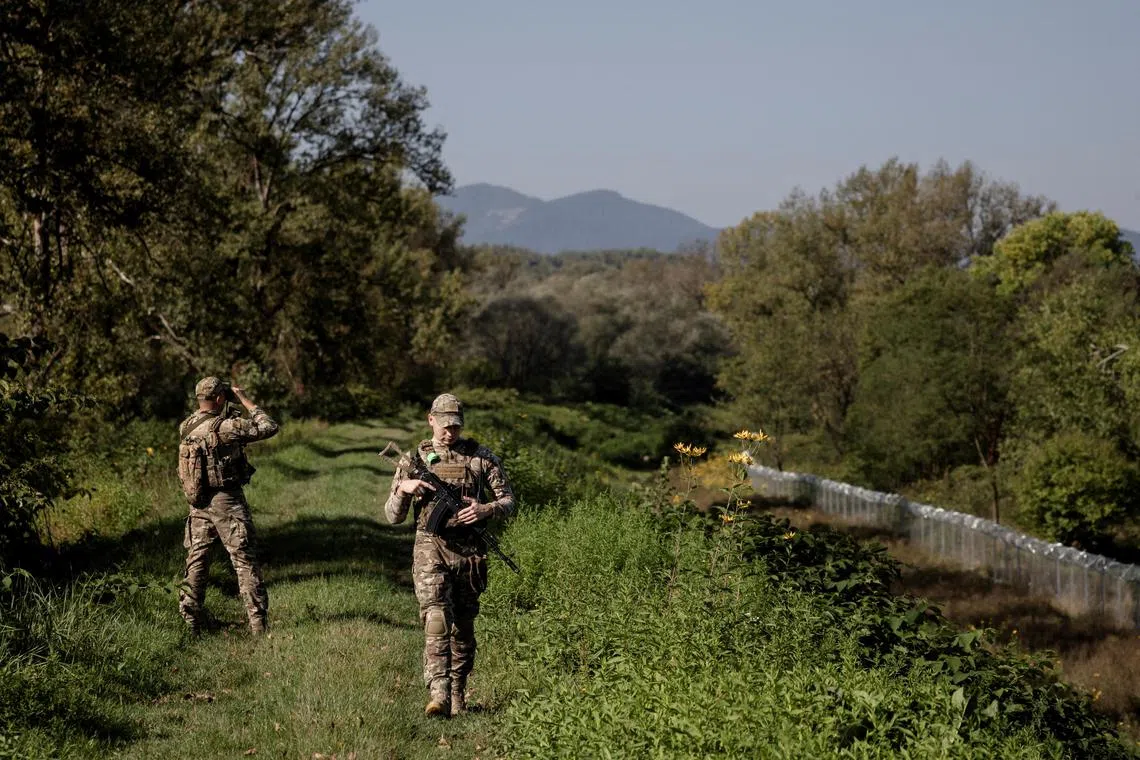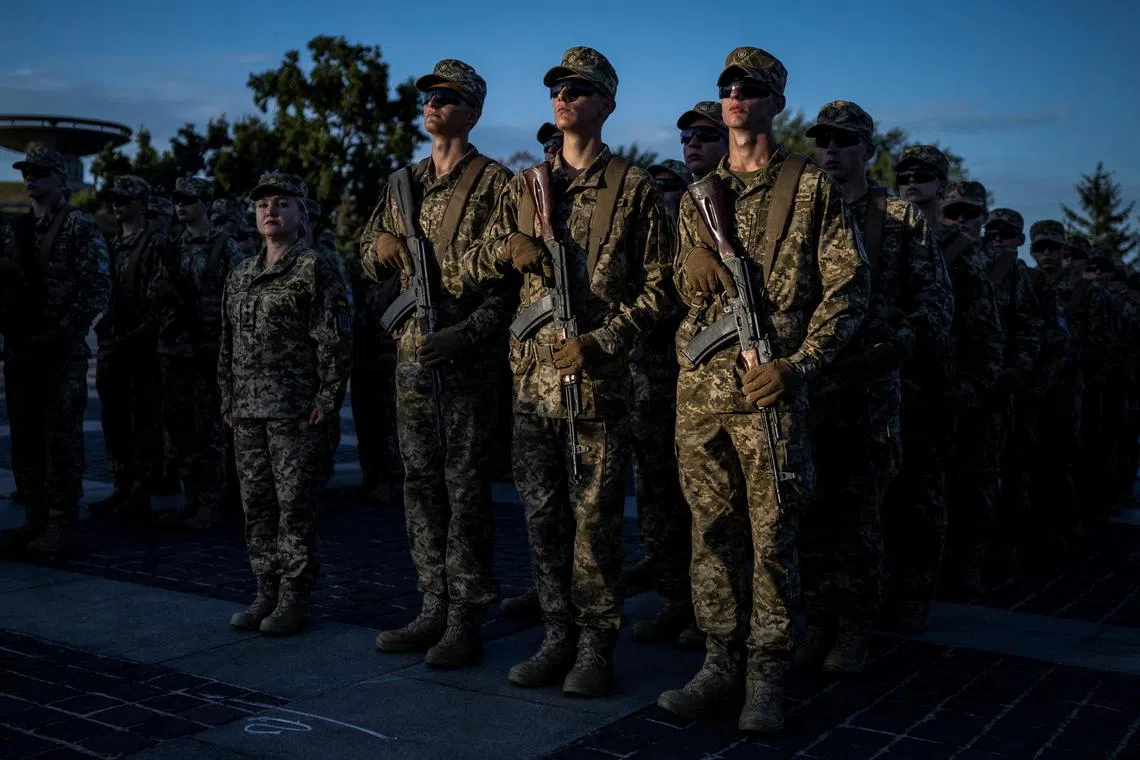‘At what cost?’: Ukraine strains to bolster its army as war fatigue weighs
Sign up now: Get ST's newsletters delivered to your inbox

Ms Antonina Danylevych attending a protest in Kyiv calling for an end to open-ended military service.
PHOTO: REUTERS
Follow topic:
KYIV - When Ms Antonina Danylevych’s husband, Oleksandr, enlisted in the Ukrainian army in March 2022, he had to line up at the draft office alongside crowds of patriotic countrymen.
There are no crowds now, she says.
Ms Danylevych, a 43-year-old human resources manager, gave her blessing when he joined tens of thousands of other Ukrainian citizens to defy the Russian invasion.
Now, she is finding it hard to cope, with no end in sight. Her husband has only had about 25 days’ home leave since he enlisted and their two children are growing up without a father.
“We want Ukraine to win but not through the efforts of the same people,” she said at her home in Kyiv.
“I can see they need to be replaced and that they also need to rest, but for some reason, other people don’t understand.”
Women on the home front have had to become stronger, she said, adding: “But at what cost did we become stronger?”
Her husband – a university lecturer with no prior combat experience and who is now a platoon commander – watched their son get married earlier in 2023 on his phone by video call from the ruined city of Bakhmut. Their 14-year-old daughter misses him.
Almost two years into the grinding war, this family and others around the country are coming to terms with the prospect of a much longer and costlier conflict than they had hoped for and one that some now acknowledge they are not guaranteed to win.
This autumn, Ms Danylevych was one of 25,000 people who signed a petition to President Volodymyr Zelensky, saying that military service cannot remain open-ended and calling for troops to be given a clear timeline for when they will be discharged.
The campaign, which included two protests by 50 to 100 people in Kyiv’s main square in recent weeks, illustrates a growing level of exhaustion among Ukrainian troops and the mounting toll on families back home.
Ukraine’s vaunted summer counteroffensive has so far failed to deliver a decisive breakthrough – both sides are dug in along largely static front lines and questions are being asked about whether foreign military aid will be as forthcoming as it was.
The country has relied on tens of billions of dollars in arms from the United States and other allies to sustain its war effort, but stockpiles of artillery shells are emptying and governments are cooler on sustaining previous levels of support.
Such protests would have been unthinkable a year ago, when national morale soared as Ukraine beat Russian forces back from Kyiv and retook swathes of the north-east and south.
Martial law, declared at the war’s start, prohibits public demonstrations.

People at a protest in Kyiv calling for an end to open-ended military service on Oct 27.
PHOTO: REUTERS
Ms Danylevych’s campaign points to difficult choices war planners face as they try to maintain the flow of recruits to defeat a much larger army amid steady losses, while retaining a big enough workforce to sustain the shattered economy.
Only Ukrainian men aged between 27 and 60 can be mobilised by draft officers.
Men aged between 18 and 26 cannot be drafted though they can enlist voluntarily.
Ukraine, which has said it has about one million people under arms, has barred military-age men from going abroad. Its constantly running mobilisation programme, which was declared at the start of the war, is a state secret. So are battlefield losses, which US estimates put in the tens of thousands.
The Ukrainian Defence Ministry referred questions for this article to the military, which declined to comment, citing wartime secrecy.
Drowned trying to flee
In November, Ukraine’s military chief said one of his priorities was to build up the army’s reserves as he laid out a plan to prevent the war from settling into a stalemate of attritional warfare that he warned would suit Russia.
The plan focuses on boosting Ukraine’s aerial and electronic warfare, and drone, anti-artillery and mine-clearance capabilities.
He said Ukraine, like Russia, had limited capacity to train troops and alluded to gaps in legislation that allowed citizens to shirk mobilisation.
“We are trying to fix these problems. We are introducing a unified register of draftees and we must expand the category of citizens who can be called up for training or mobilisation,” he wrote in rare comments published as an article by The Economist.
The recruitment process largely takes place out of the public eye. Draft officers stop men in the street, at the metro or at checkpoints and hand out call-up papers to them, instructing them to report to recruitment centres.
Over the last year, social media videos occasionally surface showing draft officers dragging away or threatening men they want to mobilise, causing public outcry.
Many Ukrainians have also been angered by a string of corruption cases
Seldom does a week go by without a law enforcement agency announcing criminal cases against people, including draft officials, accused of taking between US$500 (S$668) and US$10,000 to provide fake documents for people to shirk mobilisation or travel abroad.
At the River Tisa, which acts as the border from south-western Ukraine to Romania, guard patrols used to focus on catching tobacco smugglers but now collar fleeing draft dodgers.

Ukrainian border guards surveying the border to Romania, looking for people who cross illegally, including men attempting to flee abroad to avoid military service.
PHOTO: REUTERS
About 6,000 people have been detained trying to leave across that stretch, border guards told Reuters. One of them, Mr Dyma Cherevychenko, said at least 19 people had drowned trying to flee the country during the conflict.
“They died for nothing, died in the river when they could have contributed to the war effort,” the 29-year-old said.
University escape hatch?
The Ukrainian Parliament has been debating legislation that would stop people over the age of 30 using higher education as a legal way around mobilisation.
The number of men aged over 25 who booked places at universities in the first year of the invasion shot up by 55,000 compared with the year before, Education Minister Oksen Lisovyi wrote on Facebook in September.
Some voices in the West have suggested that Kyiv step up the scale of its recruitment by drawing on younger men.
Mr Ben Wallace, Britain’s defence minister until the end of August, said the average age of Ukrainian soldiers at the front was over 40 and suggested it was time to “reassess the scale of Ukraine’s mobilisation”.
“I understand President Zelensky’s desire to preserve the young for the future, but the fact is that Russia is mobilising the whole country by stealth,” he wrote in the Telegraph newspaper.

Only Ukrainian men aged between 27 and 60 can be mobilised by draft officers.
PHOTO: REUTERS
Mr David Arakhamia, a senior lawmaker and Zelensky ally, said on Nov 23 that Parliament planned to draw up legislation to improve the mobilisation and demobilisation procedure by the end of 2023.
The Bill, he said on television, would cover what to do with people who have been fighting for two years without rotation, how to demobilise soldiers who have returned after being prisoners of war, and also address “issues related to the conscription age”.
Tanks and tranquilisers
A temporary lull in major Russian missile and drone strikes on the capital over the summer made the war seem more distant, although that calm was shattered over the weekend as Russia launched its biggest drone assault on Kyiv.
Some sociologists say a gloomier mood has set in nationwide.
They point to surveys showing declining trust in the government, which had surged in the first months of the war when Ukrainian forces repelled Russian advances.
Mr Zelensky’s ratings remain very high although they too are down from 2022.
Trust in the government and Parliament has tumbled from 74 per cent in 2022 to 39 per cent, and 58 per cent to 21 per cent, respectively, according to Mr Anton Hrushetskyi, executive director at the Kyiv International Institute of Sociology, a research organisation.
“We’d hoped to be in a better position this autumn than we are right now,” he said.
Mr Hrushetskyi said other contributing factors were various corruption scandals and a belief that Western military supplies for Ukraine could and should have been more robust.
Ms Danylevych is now preparing her home for what many Ukrainians fear will be another winter of Russian air strikes that will target the power grid and energy system, causing sweeping blackouts and other outages.
“I feel depressed because I understand all the challenges of winter and if there is heavy shelling and there is neither electricity nor heating, I will have to face all these problems on my own.”

Ms Antonina Danylevych’s husband has been fighting against Russia’s invasion on Ukraine since March 2022.
PHOTO: REUTERS
Her husband Oleksandr and his unit, Ukraine’s fourth tank brigade, could not be reached for comment.
This summer, Ms Danylevych stumbled across a group on the Telegram messaging platform that now has 2,900 like-minded people including wives, mothers and other family members who banded together to campaign for the right of war veterans to be demobilised.
“A lot of the women are on sedatives and tranquilisers,” she said, describing a “very depressed” mood of resignation among them.
The group staged a first demonstration of around 100 people in Kyiv’s Independence Square on Oct 27, after which they wrote a letter addressed to Mr Zelensky to make their case. No police action was taken against them.
Dozens of them returned to the square for a further protest in the rain on Nov 12.
One held up a sign saying: “My husband and father have given others the time to get ready. It’s time to replace the first people!” REUTERS

